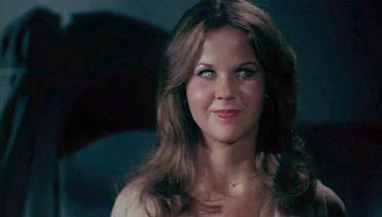Chapter Two
Exorcist II: The Heretic
By Brett Ballard-Beach
September 1, 2011
In the Heretic, Regan is a frequent visitor at a psychiatric institute where Dr. Gene Tuskin works (the layout of said institute is a marvel of production design with interconnected glass rooms that reveal one another’s inhabitants almost as if by cross-section). Convinced that Regan has deeply repressed her memories of the first film’s events (which Regan denies), Tuskin convinces her to use a boxy device called the synchronizer - like a hypnotist’s twirling pen or gold locket crossed with a weather vane and spruced up with blinding light bulbs - that will allow a pair of participants to “go under” simultaneously and then link together their brainwaves through biofeedback.
As matter of factly as the first film dealt with the possibility of demonic possession, does The Heretic allow for this procedure to take place, with the added bonus that Regan has strong psychic skills to boot. Goodhart’s screenplay clumsily and confusingly dumps all of this information on the audience - that is, if I have even begun to accurately capture what he attempts to convey - and then adds on top of that the re-emergence of the demon from The Exorcist, here dubbed “Pazuzu," and its connection to an African boy - once exorcised by Father Merrin - whose name is Kokumo (which nobody in the film pronounces the same way, a fact confusing in itself.) At times, the plot seems as dense as the Coen brothers’ Miller’s Crossing, only with none of the quotable dialogue.
The synchronizer is charmingly low-tech, but the dual flashing lights grow wearisome and the efforts of those who hook up to the machine to embody a deep state of hypnosis (monotone, glassy eyes, dead gaze) are epic fails. And in large part, the plot rests on this (well that, and locust herding but I’m getting ahead of myself). A year later, Warner Bros would help the world believe a man could fly, but here they cannot capture the mood of a deep state of suggestiveness without provoking an even deeper state of laughter.
This leads into the second key area of trouble: the performances. Richard Burton may have been a tyro in most every other genre on stage and screen, but as the lead in a special effects-filled horror film (playing Father Lamont), he is adrift. Even in his more restrained moments, he appears to be inching towards bug-eyed, sweat-drenched lunacy. When this coincides with similar tonal shifts in the material, it can be passed off as genius. The rest of the time Burton wears the mark of an actor stubbornly refusing to cop to the fact that he has taken a gig for the paycheck, and overcompensating with too much thespian flair (post-Hannibal Lecter Anthony Hopkins would have found the right tone, I think).
Blair was largely ridiculed for being either out of her depth or too flat and ridiculously underplaying her role, but opposite Burton, and in the context of the lunacy of the plot, her efforts, whether conscious or the results of acting limitations, seem inspired. This isn’t to say that it’s a great performance but she is sunny, friendly, and charmingly matter of fact.
What the film seems conflicted about, however, is what to do with the fact that between ’73 and ’77 - ages 12 and 16 - Blair went from child to near-woman. Boorman isn’t interested in any kind of recurring sexual exploitation and her grown-up figure isn’t made much of until the climax (set back in the McNeil home) where a Regan-doppelganger decked out in a revealing nightgown attempts to coerce Lamont into killing Regan (this in the midst of a plague of locusts, a wind and light phantasmagoria, and the house itself seemingly being rent in two by the forces of evil.) And if one of the many subtexts of the first film would seem to be the punishment of a young girl on the verge of becoming a woman by brutalizing her and equating her to a vile, profanity-spewing demon, then it would have been enlightened for the sequel to excise the scene or deal more fully with the implications throughout.
If The Exorcist succeeded by subsuming the horrific into the everyday and lending everything the shade of a waking nightmare, then The Heretic is saved (to some degree) from sinking into a morass of under realized ideas through technical flourishes that drape everything in the heightened urgency of a fever dream. From Regan’s sleepwalking forays towards the edge of the Chrysler Building’s roof to soaring cinematography that pushes across African savannas with the POV of a swarm of grasshoppers to the chaos of blood and glass and flames that mark the out-of-left-field car crash near the film’s ending, there is a bounty of visual flair that makes the film come alive in one’s mind when sifted through in retrospect, outside of and separate from the tricky proposition of actually sitting through the film again. If not for all the baggage that comes with, you know, actually being a sequel to The Exorcist, The Heretic might have carved out its own space on the shelf of cult classics. As it stands, it hasn’t even worked its way up to underdog status.
Next time: If you want to believe, then go ahead and believe. The truth is out there.
Continued:
1
2
3
4
5




